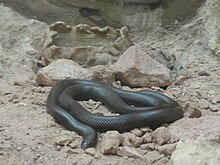

| Atractaspis | |
|---|---|

| |
| Atractaspis engaddensis | |
| Scientific classification | |
| Domain: | Eukaryota |
| Kingdom: | Animalia |
| Phylum: | Chordata |
| Class: | Reptilia |
| Order: | Squamata |
| Suborder: | Serpentes |
| Family: | Atractaspididae |
| Subfamily: | Atractaspidinae |
| Genus: | Atractaspis A. Smith, 1849 |
Atractaspis is a genusofvenomous snakes in the family Atractaspidae, also known as the stiletto snakes. The genus is endemictoAfrica and the Middle East. The genus contains 15 species that are recognized by ITIS.[2] Others recognize as many as 21 species.[3][4][5] 23 are listed here.
Common names for snakes of the genus Atractaspis include burrowing vipers, burrowing asps, mole vipers, stiletto snakes, side-stabbing snakes, side-stabbers. "Side stabbing" refers to the snakes' uncommon ability to strike with the side of their head and inject venom with one protruding fang.[1]
Species of the genus Atractaspis are found mostly in Sub-Saharan Africa, with a limited distribution in the Jordan valleyinIsrael, Palestine and the Arabian Peninsula.[1]
Members of the genus Atractaspis share the following characteristics. Venom fangs enormously developed; a few teeth on the palatines, none on the pterygoids; mandibles edentulous anteriorly, with 2 or 3 very small teeth in the middle of the dentary bone. Postfrontal bone absent. Head small, not distinct from neck, covered with large symmetrical shields; nostril between 2 nasals; no loreal; eye minute, with round pupil. Body cylindrical; dorsal scales smooth, without apical pits, in 17 to 37 rows; ventrals rounded. Tail short; subcaudals either single or in two rows.[6]
| Species[2][4] | Taxon author*[2][4] | Subspecies**[2] | Common name[1] | Geographic range[4][1] |
|---|---|---|---|---|
| A. andersonii | Boulenger, 1905 | Oman, Yemen | ||
| A. aterrima | Günther, 1863 | ———— | slender burrowing asp | Africa: from Senegal and the Gambia east to DR Congo and Uganda. |
| A. battersbyi | de Witte, 1959 | ———— | Battersby's burrowing asp | Africa: Bolobo, on the Congo River basin, DR Congo. |
| A. bibronii | A. Smith, 1849 | bibronii
rostrata |
Bibron's burrowing asp | Southern Africa, from central Namibia, east to northern South Africa, north to south-eastern DR Congo, eastern Tanzania, coastal Kenya, and extreme southern coastal Somalia. |
| A. boulengeri | Mocquard, 1897 | matschiensis mixta schmidti schultzei vanderborghti |
Central African burrowing asp | Africa: the forests of the western Congo River basin. |
| A. branchi | Rödel et al., 2019 | Branch's stiletto snake | Africa: from Liberia to Guinea | |
| A. congica | W. Peters, 1877 | leleupi orientalis |
Congo burrowing asp | Africa: from the mouth of the Congo River south to Angola, south-eastern DR Congo and northern Zambia. |
| A. corpulenta | (Hallowell, 1854) | kivuensis leucura |
fat burrowing asp | Africa: from Liberia to Ghana and from Nigeria eastwards to north-eastern DR Congo. |
| A. dahomeyensis | Bocage, 1887 | ———— | Dahomey burrowing asp | Africa: from southwestern Cameroon, north and west through Nigeria, Benin, Togo, Ghana, north-western Ivory Coast, south-western Burkina Faso and south-central Mali. |
| A. duerdeni | Gough, 1907 | ———— | Duerden's burrowing asp | Africa in two isolated populations: one in north-central Namibia and one in south-eastern Botswana and northern South Africa. |
| A. engaddensis | Haas, 1950 | En-Gedi asp, alasawad alkhabith | Asia: Israel, Palestine, Saudi Arabia, Lebanon | |
| A. engdahli | Lönnberg & Andersson, 1913 | ———— | Engdahl's burrowing asp | Africa: southern Somalia and the lower Juba Valley northwest into northeastern Kenya. |
| A. fallax | W. Peters, 1867 | ———— | Ethiopia, Kenya, Somalia | |
| A. irregularis | (J.T. Reinhardt, 1843) | angeli bipostocularis conradsi parkeri uelensis |
variable burrowing asp | Africa: from Liberia to Ghana, from Nigeria east to Uganda, southern Sudan, and western and central Kenya, and south to north-eastern Tanzania, DR Congo and north-western Angola. |
| A. leucomelas | Boulenger, 1895 | ———— | Ogaden burrowing asp | Africa: eastern Ethiopia, northwestern Somalia and Djibouti. |
| A. magrettii | Scortecci, 1928 | western Eritrea, northwestern Ethiopia, south-eastern Sudan | ||
| A. microlepidota | Günther, 1866 | small-scaled burrowing asp | Africa: Senegal, Gambia, southern Mauritania, and western Mali | |
| A. micropholis | Günther, 1872 | Burkina Faso, Mali, Niger, Nigeria | ||
| A. phillipsi | Barbour, 1913 | south-eastern Sudan | ||
| A. reticulata | Sjöstedt, 1896 | brieni heterochilus |
reticulate burrowing asp | Central Africa: from southern Cameroon, east to eastern DR Congo and south to Angola. |
| A. scorteccii | Parker, 1949 | ———— | Somali burrowing asp | Africa: eastern Ethiopia and northern Somalia. |
| A. watsoni | Boulenger, 1908 | Watson' s
Burrowing Asp |
Burkina Faso, Cameroon, Chad, Central African Republic, Mali, Mauritania, Niger, Nigeria, Senegal |
*) A taxon author in parentheses indicates that the species was originally described in a genus other than Atractaspis.
**) Not including the nominate subspecies.
| Atractaspis |
|
|---|---|
| Authority control databases: National |
|
|---|